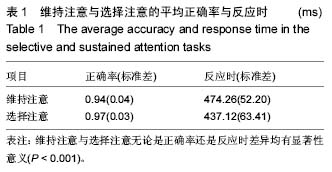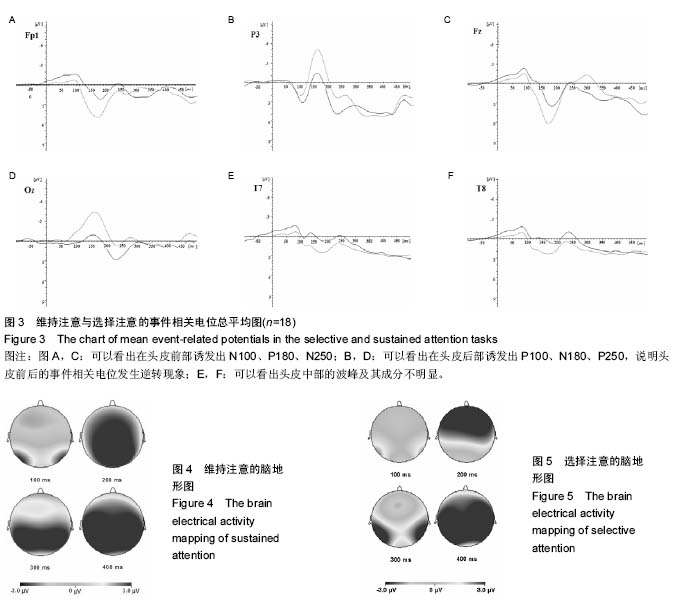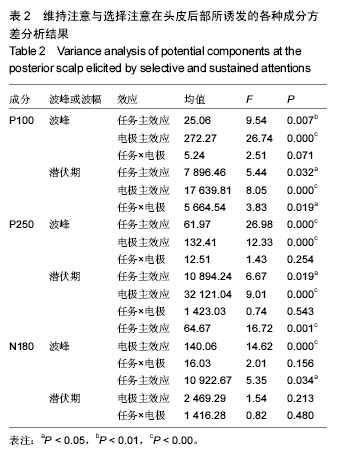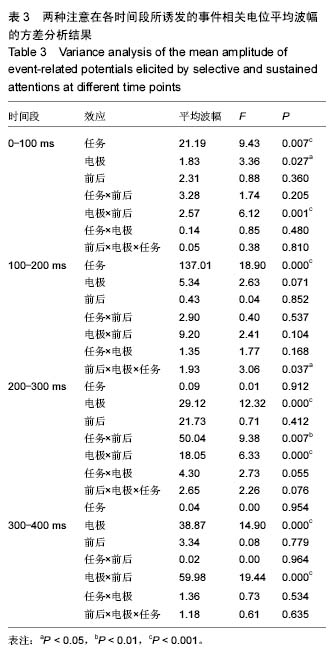中国组织工程研究 ›› 2016, Vol. 20 ›› Issue (33): 4993-4998.doi: 10.3969/j.issn.2095-4344.2016.33.018
• 组织构建临床实践 clinical practice in tissue construction • 上一篇 下一篇
维持注意与选择注意具有不同的脑机制:来自事件相关电位的证据
王金娥,任国防
- 安阳师范学院,河南省安阳市 455000
Differences of brain mechanism between selective attention and sustained attention: evidences from event-related potentials
Wang Jin-e, Ren Guo-fang
- Anyang Normal University, Anyang 455000, Henan Province, China
摘要:
文章快速阅读:
.jpg) 文题释义:
事件相关电位:是一种特殊的脑诱发电位,通过有意地赋予刺激以特殊的心理意义,利用多个或多样的刺激所引起的脑的电位。它反映了认知过程中大脑的神经电生理的变化,也被称为认知电位,也就是指当人们对某课题进行认知加工时,从头颅表面记录到的脑电位。
注意:是心理活动对一定对象的指向和集中。是伴随着感知觉、记忆、思维、想象等心理过程的一种共同的心理特征。注意有两个基本特征,一个是指向性,是指心理活动有选择的反映一些现象而离开其余对象;二是集中性,是指心理活动停留在被选择对象上的强度或紧张度。指向性表现为对出现在同一时间的许多刺激的选择,即选择注意;集中性表现为对干扰刺激的抑制,即注意的持续性,维持注意。
文题释义:
事件相关电位:是一种特殊的脑诱发电位,通过有意地赋予刺激以特殊的心理意义,利用多个或多样的刺激所引起的脑的电位。它反映了认知过程中大脑的神经电生理的变化,也被称为认知电位,也就是指当人们对某课题进行认知加工时,从头颅表面记录到的脑电位。
注意:是心理活动对一定对象的指向和集中。是伴随着感知觉、记忆、思维、想象等心理过程的一种共同的心理特征。注意有两个基本特征,一个是指向性,是指心理活动有选择的反映一些现象而离开其余对象;二是集中性,是指心理活动停留在被选择对象上的强度或紧张度。指向性表现为对出现在同一时间的许多刺激的选择,即选择注意;集中性表现为对干扰刺激的抑制,即注意的持续性,维持注意。
.jpg) 文题释义:
事件相关电位:是一种特殊的脑诱发电位,通过有意地赋予刺激以特殊的心理意义,利用多个或多样的刺激所引起的脑的电位。它反映了认知过程中大脑的神经电生理的变化,也被称为认知电位,也就是指当人们对某课题进行认知加工时,从头颅表面记录到的脑电位。
注意:是心理活动对一定对象的指向和集中。是伴随着感知觉、记忆、思维、想象等心理过程的一种共同的心理特征。注意有两个基本特征,一个是指向性,是指心理活动有选择的反映一些现象而离开其余对象;二是集中性,是指心理活动停留在被选择对象上的强度或紧张度。指向性表现为对出现在同一时间的许多刺激的选择,即选择注意;集中性表现为对干扰刺激的抑制,即注意的持续性,维持注意。
文题释义:
事件相关电位:是一种特殊的脑诱发电位,通过有意地赋予刺激以特殊的心理意义,利用多个或多样的刺激所引起的脑的电位。它反映了认知过程中大脑的神经电生理的变化,也被称为认知电位,也就是指当人们对某课题进行认知加工时,从头颅表面记录到的脑电位。
注意:是心理活动对一定对象的指向和集中。是伴随着感知觉、记忆、思维、想象等心理过程的一种共同的心理特征。注意有两个基本特征,一个是指向性,是指心理活动有选择的反映一些现象而离开其余对象;二是集中性,是指心理活动停留在被选择对象上的强度或紧张度。指向性表现为对出现在同一时间的许多刺激的选择,即选择注意;集中性表现为对干扰刺激的抑制,即注意的持续性,维持注意。摘要
背景:目前,学者们对注意的研究主要集中于注意与其他心理现象之间的关系,而对注意自身的不同类型,如维持注意与选择注意之间的比较,却较少研究。
目的:维持注意与选择注意作为两种不同的注意类型,在认知加工中的作用明显不同,探讨它们是否具有不同的脑机制。
方法:随机选取18名大学生,男女各半,测量他们在进行两种注意任务时的事件相关电位。实验程序用E-Prime编写并在计算机上呈现,实验任务由Karl等人的实验范式修改而来,包括选择注意测试流程和维持注意测试流程。呈现注视点500 ms,然后随机出现3个并排的图形,呈现时间为300 ms。要求受试者按要求尽可能快速而准确的做出反应。
结果与结论:表明2种注意具有不同的认知神经机制:维持注意与选择注意在时间进程及波峰和潜伏期方面都存在显著差异。维持注意所诱发的脑电波在脑区分布上更广泛,以正波为主,而选择注意所诱发的脑电波由正波和负波2种;维持注意诱发出更大的N100和N250成分,但在中期阶段,选择注意诱发的P180波要大。这可能表明对事物的选择出现在任务的中期阶段;两种注意任务所诱发的事件相关电位在头皮前后发生逆转现象,很可能是所有注意都具有的特性。
中国组织工程研究杂志出版内容重点:组织构建;骨细胞;软骨细胞;细胞培养;成纤维细胞;血管内皮细胞;骨质疏松;组织工程
ORCID: 0000-0002-1443-0883(王金娥)
中图分类号:




.jpg)
.jpg)
.jpg) 文题释义:
事件相关电位:是一种特殊的脑诱发电位,通过有意地赋予刺激以特殊的心理意义,利用多个或多样的刺激所引起的脑的电位。它反映了认知过程中大脑的神经电生理的变化,也被称为认知电位,也就是指当人们对某课题进行认知加工时,从头颅表面记录到的脑电位。
注意:是心理活动对一定对象的指向和集中。是伴随着感知觉、记忆、思维、想象等心理过程的一种共同的心理特征。注意有两个基本特征,一个是指向性,是指心理活动有选择的反映一些现象而离开其余对象;二是集中性,是指心理活动停留在被选择对象上的强度或紧张度。指向性表现为对出现在同一时间的许多刺激的选择,即选择注意;集中性表现为对干扰刺激的抑制,即注意的持续性,维持注意。
文题释义:
事件相关电位:是一种特殊的脑诱发电位,通过有意地赋予刺激以特殊的心理意义,利用多个或多样的刺激所引起的脑的电位。它反映了认知过程中大脑的神经电生理的变化,也被称为认知电位,也就是指当人们对某课题进行认知加工时,从头颅表面记录到的脑电位。
注意:是心理活动对一定对象的指向和集中。是伴随着感知觉、记忆、思维、想象等心理过程的一种共同的心理特征。注意有两个基本特征,一个是指向性,是指心理活动有选择的反映一些现象而离开其余对象;二是集中性,是指心理活动停留在被选择对象上的强度或紧张度。指向性表现为对出现在同一时间的许多刺激的选择,即选择注意;集中性表现为对干扰刺激的抑制,即注意的持续性,维持注意。